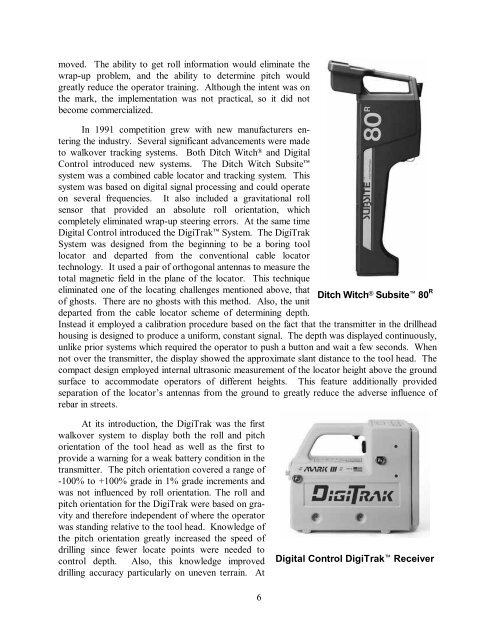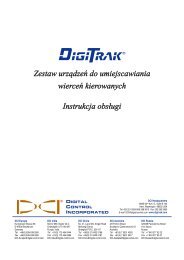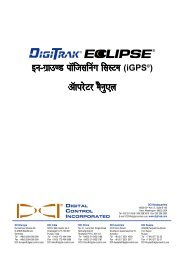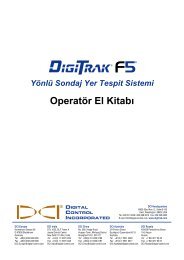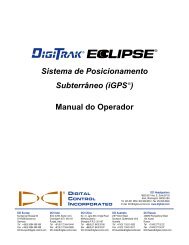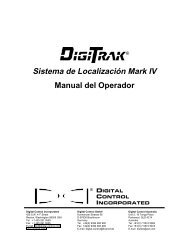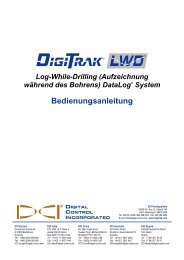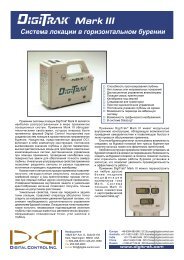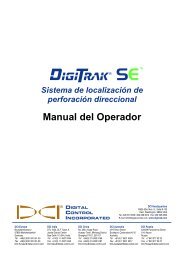history of walkover locating technology - Digital Control Inc.
history of walkover locating technology - Digital Control Inc.
history of walkover locating technology - Digital Control Inc.
You also want an ePaper? Increase the reach of your titles
YUMPU automatically turns print PDFs into web optimized ePapers that Google loves.
moved. The ability to get roll information would eliminate thewrap-up problem, and the ability to determine pitch wouldgreatly reduce the operator training. Although the intent was onthe mark, the implementation was not practical, so it did notbecome commercialized.In 1991 competition grew with new manufacturers enteringthe industry. Several significant advancements were madeto <strong>walkover</strong> tracking systems. Both Ditch Witch ® and <strong>Digital</strong><strong>Control</strong> introduced new systems. The Ditch Witch Subsite system was a combined cable locator and tracking system. Thissystem was based on digital signal processing and could operateon several frequencies. It also included a gravitational rollsensor that provided an absolute roll orientation, whichcompletely eliminated wrap-up steering errors. At the same time<strong>Digital</strong> <strong>Control</strong> introduced the DigiTrak System. The DigiTrakSystem was designed from the beginning to be a boring toollocator and departed from the conventional cable locator<strong>technology</strong>. It used a pair <strong>of</strong> orthogonal antennas to measure thetotal magnetic field in the plane <strong>of</strong> the locator. This techniqueeliminated one <strong>of</strong> the <strong>locating</strong> challenges mentioned above, thatDitch Witch<strong>of</strong> ghosts. There are no ghosts with this method. Also, the unit® Subsite 80 Rdeparted from the cable locator scheme <strong>of</strong> determining depth.Instead it employed a calibration procedure based on the fact that the transmitter in the drillheadhousing is designed to produce a uniform, constant signal. The depth was displayed continuously,unlike prior systems which required the operator to push a button and wait a few seconds. Whennot over the transmitter, the display showed the approximate slant distance to the tool head. Thecompact design employed internal ultrasonic measurement <strong>of</strong> the locator height above the groundsurface to accommodate operators <strong>of</strong> different heights. This feature additionally providedseparation <strong>of</strong> the locator’s antennas from the ground to greatly reduce the adverse influence <strong>of</strong>rebar in streets.At its introduction, the DigiTrak was the first<strong>walkover</strong> system to display both the roll and pitchorientation <strong>of</strong> the tool head as well as the first toprovide a warning for a weak battery condition in thetransmitter. The pitch orientation covered a range <strong>of</strong>-100% to +100% grade in 1% grade increments andwas not influenced by roll orientation. The roll andpitch orientation for the DigiTrak were based on gravityand therefore independent <strong>of</strong> where the operatorwas standing relative to the tool head. Knowledge <strong>of</strong>the pitch orientation greatly increased the speed <strong>of</strong>drilling since fewer locate points were needed tocontrol depth. Also, this knowledge improveddrilling accuracy particularly on uneven terrain. At<strong>Digital</strong> <strong>Control</strong> DigiTrak Receiver6


